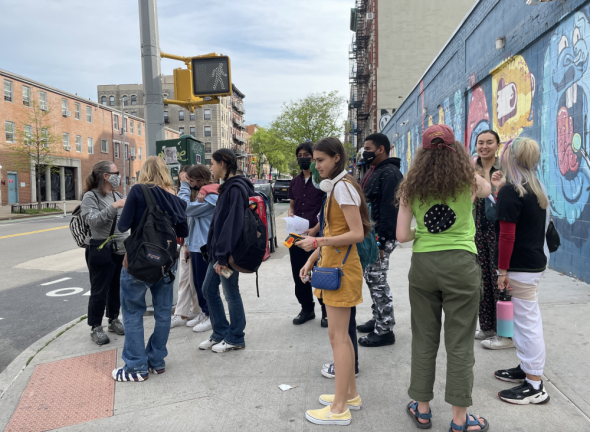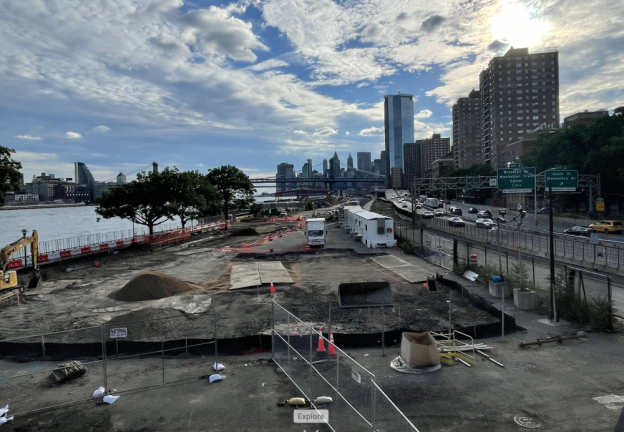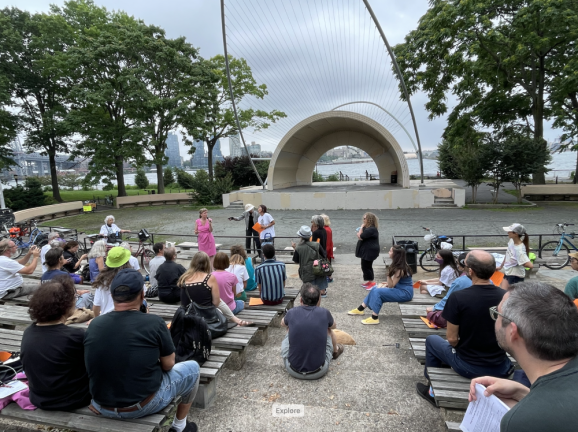LES, Breathe!
An air monitoring system run by community members on the Lower East Side fights for environmental justice



A group of high schoolers from Sixth Street Community Center took a walk through their Lower East Side neighborhood this spring. Using small handheld devices, the group took measurements too small for the human eye to catch: air quality. The youth sensor tour also measured temperature through a portable temperature gun so students could see the difference greenery makes in keeping their neighborhood cool. Wendy Brawer, eco-designer and cultural creative who helped organize the walking tour, said the temperature sensor even showed the heat difference between street pavement and the white pavement markings.
Finding ways to help others understand what’s happening in their community and ask questions about their environment is what Brawer is all about. It’s why she co-founded LES Breathe, a community committee within the nonprofit East River Park Action that monitors neighborhood air quality. “It’s information that all of us need to know more about because it’s part of our daily life,” said Brawer. “It’s in the air we breathe.”
LES Breathe empowers community members to be “citizen scientists,” and like the high schoolers on the youth sensor tour, get hands-on experience in how environmental issues are part of daily life. “It’s a hyperlocal way of understanding environmental justice,” said Anna Tsomo-Leidecker, Teen Program Director at Sixth Street Community Center who coordinated with Brawer and LES Breathe co-founder Mary Jo Burke in organizing the walking tour.
The air quality monitors used by LES Breathe look at air pollutants of a breathable size known as fine particulate matter or PM 2.5, particles in the air with a diameter of 2.5 micrometers or smaller. When air pollutant levels are high, it can pose a threat to public health by increasing the risk of respiratory infections, heart disease, stroke, and even lung cancer. Areas with poor air quality have also been found to have higher death rates during the COVID-19 pandemic.
The densely populated area of lower Manhattan is susceptible to negative health impacts due to numerous ongoing construction projects, the proximity to the six-laned FDR Drive where auto emissions fill the air day and night, and other environmental risks. Especially in light of the East Side Coastal Resiliency project, LES Breathe works to make real-time air quality data accessible to the public.
East Side Coastal Resiliency (ESCR) Project
The $1.45 billion flood protection project, funded by the City of New York and the federal government, intends to protect Manhattan’s East Side from coastal storms and sea-level rise. The project is in the midst of building a 1.2-mile storm wall along the coast as well as leveling the East River Park in order to raise it by laying down eight to ten feet of landfill. The project broke ground in 2021 and is expected to continue through 2026.
The ESCR has received significant pushback from the community over its environmental impact. The most controversial aspect of the plan has been the planned removal of 1,000 trees from East River Park of which the city has currently removed around 700. Not only does the ongoing construction from the ESCR create air pollution but the removal of trees, which act as natural air cleaners, decreases available fresh air.
The ESCR has limits on the amount of air pollution that can be produced through construction and provides the community with quarterly air quality monitoring summaries. They have also developed an “Air Quality Management Plan” which includes daily air quality mitigation techniques, daily air quality monitoring, and air quality oversight by environmental specialists.
In the ESCR Final Environmental Impact Assessment, the City of New York found emissions from vehicles as well as “dust-generating” construction activities have the potential to affect air quality. However, due to their management plan, they stated, “No significant adverse air quality impacts are predicted from the construction.”
While the construction continues, the public has no real-time access to the monitoring data, so the air quality monitoring summaries aren’t conducive to responding to air pollution levels daily. The long-term impact of these impacts on air quality is also unknown.
When the ESCR construction began, Brawer began to hear more community concerns about public health. “We thought what is the one thing we can do that might help everybody across the board, and that would be to start working on air quality issues,” said Brawer.
Environmental Health Risks
Along with outside air, indoor air quality is equally important. People spend a large amount of time inside, especially during the pandemic. LES Breathe has created flyers that list easy ways to improve indoor air. Some suggestions include opening windows when cooking, not smoking indoors, growing plants, and not using products like nail polish inside.
The youth sensor tour had an indoor air pollutant session where they tested sharpies, hand sanitizer, nail polish and other household items. The group saw higher ratings on the indoor air they tested in comparison to the outdoor readings near FDR Drive due to the windy day. Outdoor air is more fluid due to wind, rain, and other environmental factors while indoor air often stays stagnant. “Seeing the needle immediately go to red on the sensor really stuck with folks,” said Tsomo-Leidecker.
In addition to community outreach and policy work, LES Breathe has also identified other environmental concerns that could potentially impact public health. For example, in September 2020 LES Breathe found lead present in soil samples collected from under the Williamsburg Bridge. East River Park Action submitted a FOIL (Freedom of Information Law) request from the city and received a 2,000-page report of data collected from the park. The documentation revealed, “Elevated levels of arsenic, lead, and/or mercury were identified throughout the investigation areas.”
The East River Park was built with landfill laid down in the 1930s. Testing of the site has revealed chemicals, a former gas manufacturing site near 10th Street, and a large amount of groundwater which will require an extensive dewatering process.
Purple Air
Shortly after the organization launched, LES Breathe purchased outdoor air quality monitors from Purple Air, which places real-time data from sensors on a publicly accessible map. LES Breathe purchased and installed four sensors which have been collecting data for about a year and the group has one device available for a fifth sensing location.
The sensors collect baseline data on temperature, humidity, PM 2.5, etc. At separate locations in the East Village and Lower East Side, the sensors are set up on a tenth floor, a first floor, and a fifth floor to capture different data sets. Additionally, LES Breathe has acquired Atmotubes, portable monitors which can be placed indoors or can be brought on a daily commute to test air quality.
On the Purple Air map, air quality is shown in a range of green to red indicating increasing levels of pollution. A reading of 0-50 is good, 51-100 is acceptable, and the scale goes up to 201-300 which would indicate a significant health alert. The sensors also appear on Google Maps when the air quality layer is applied.
In addition to organizing walking tours, LES Breathe has also loaned out its portable sensors for educational purposes and community research. “Anyone can be a citizen scientist,” said Tsomo-Leidecker who talked to her students after the tour about how accessible this kind of research is. “Anyone can go out, take measurements, and ask questions. You don’t need a science degree.”
Brawer, Mary Jo Burke, and the LES Breathe committee of East River Park Action encourage anyone who is interested to get involved locally and to reach out if they have questions (lesbreathe@gmail.com).
More information about LES Breathe can be found on their website (https://eastriverparkaction.org/breath) as well as information about the air quality sensors (https://eastriverparkaction.org/sensors/). Check out the sensor readings on Purple Air (https://map.purpleair.com/1/mAQI/a10/p604800/cC0?select=46755#14.73/40.75224/-73.96338).